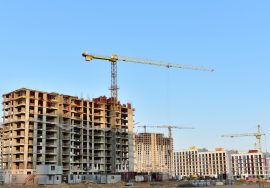
Carbon Footprint Reduction in Construction: A Path to Greener Building
Carbon Footprint Reduction in Construction: A Path to Greener Building
The global construction sector is responsible for a significant share of greenhouse gas emissions, making carbon footprint reduction in construction a crucial priority. As cities expand and infrastructure grows, builders, architects, and policymakers are adopting new technologies and sustainable practices to reduce emissions at every stage of a building’s life cycle. Today, achieving carbon footprint reduction in construction is not only an environmental responsibility but also an essential step toward future-ready, cost-efficient building development.
Why Carbon Footprint Reduction in Construction Is Essential
Construction activities—from material manufacturing to on-site operations—generate large amounts of carbon dioxide. Cement production, heavy machinery, and inefficient energy use are among the biggest contributors. By prioritising carbon footprint reduction in construction, the industry can significantly minimise environmental damage while enhancing long-term building performance.
Reducing carbon emissions helps conserve natural resources, lowers operational costs, and supports global climate commitments such as India’s pledge to achieve net-zero emissions by 2070.
Major Sources of Carbon Emissions in Construction
1. Material Production and Transportation
Traditional materials like cement, steel, and concrete have high embodied carbon. Transporting these materials further increases emissions, making their footprint even larger.
2. On-Site Construction Activities
Machinery, generators, and inefficient workflows add to the carbon load. Implementing smart equipment and clean technologies supports carbon footprint reduction in construction.
3: Building Operations
Heating, cooling, and lighting contribute heavily to long-term carbon emissions. Energy-efficient designs play a major role in reducing operational carbon.
Strategies for Carbon Footprint Reduction in Construction
Adopt Low-Carbon Building Materials
Materials like fly-ash concrete, recycled steel, bamboo, CSEB blocks, and timber significantly reduce embodied carbon. These alternatives are key to achieving carbon footprint reduction in construction.
Improve Energy Efficiency in Buildings
Passive solar design, natural ventilation, smart insulation, and high-performance windows reduce energy consumption. This supports both sustainability and cost savings throughout a building’s lifespan.
Use Renewable Energy Sources
Solar panels, solar rooftops, and hybrid systems allow buildings to generate clean power. Integrating renewable energy contributes directly to carbon footprint reduction in construction.
Optimise Construction Workflows
Reducing wastage, recycling site materials, and using efficient machinery helps minimise emissions during construction. Digital tools like BIM (Building Information Modelling) also improve planning and reduce rework.
Promote Green Certifications
Certifications like GRIHA and IGBC guide builders toward sustainable practices that contribute to carbon footprint reduction in construction. They set standards for energy use, materials, water management, and waste control.
For more Indian insights on sustainable development, you may explore the GRIHA Council.
Benefits of Carbon Footprint Reduction in Construction
Cost Savings Over Time
Lower energy bills, reduced material waste, and improved building efficiency yield significant financial benefits.
Enhanced Building Performance
Buildings that focus on carbon footprint in construction are more resilient, energy-efficient, and comfortable for occupants.
Increased Market Value
Green buildings are in high demand, attracting environmentally conscious investors and tenants.
Support for Climate Goals
By adopting low-carbon practices, the construction sector contributes to national and global climate action.

Carbon Footprint in Construction in India’s Sustainable Growth
India’s construction industry is rapidly transitioning toward green technologies. Government missions like Smart Cities, AMRUT, and Solar Rooftop initiatives encourage large-scale adoption of low-carbon practices.
Builders looking for expert guidance, material sourcing, or sustainable solutions can connect through.
Achieving carbon footprint in construction is becoming a key competitive advantage for developers and architects across India.
Final Thoughts
Carbon footprint in construction is no longer optional—it is essential for building a sustainable future. With low-carbon materials, renewable energy, efficient design, and modern technologies, the industry can significantly reduce emissions while increasing building value. As India continues to urbanise, adopting these practices will ensure healthier, greener, and more responsible infrastructure for generations to come.
Read more related articles to enhance your knowledge and make informed decisions
Cost-Effective Modular Construction: Fast, and Sustainable Building Solutions
Smart Modular Buildings: Innovative, Efficient, and Sustainable Construction








